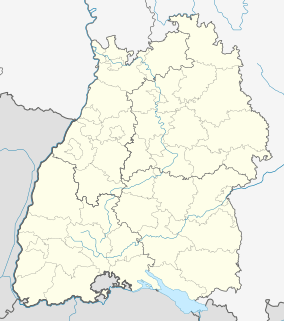Weissach im Tal
Weissach im Tal is a municipality (Gemeinde) in the Rems-Murr-Kreis district of Baden-Württemberg, Germany. It belongs to the metropolitan region of Stuttgart . On 31 December 2005 it had a population of 7,205. Weissach im Tal is twinned with Marly in France and Lommatzsch in Saxony. Mayor is Ian Schölzel. Weissach im Tal is one of a few municipalities in Rems-Murr district, which has no areas. In Aichholzhof is the biggest school complex, called "Bildungszentrum Weissach im Tal, with all three types of schools after the elementary school (Hauptschule, Realschule and Gymnasium) around a radius of about 30 km (~16,6 nm).
Weissach im Tal | |
|---|---|
 Coat of arms | |
Location of Weissach im Tal 
| |
 Weissach im Tal  Weissach im Tal | |
| Coordinates: 48°55′46″N 09°28′43″E | |
| Country | Germany |
| State | Baden-Württemberg |
| Admin. region | Stuttgart |
| District | Rems-Murr-Kreis |
| Government | |
| • Mayor | Ian Schölzel |
| Area | |
| • Total | 14.14 km2 (5.46 sq mi) |
| Elevation | 265 m (869 ft) |
| Population (2018-12-31)[1] | |
| • Total | 7,354 |
| • Density | 520/km2 (1,300/sq mi) |
| Time zone | CET/CEST (UTC+1/+2) |
| Postal codes | 71550–71554 |
| Dialling codes | 07191 |
| Vehicle registration | WN |
| Website | www.weissach-im-tal.de |
History
- 5000-2000 BC: first signs of human life in the vicinity
- 16 July 1027: first documented mention of the Weissach brook
- 1231: first documented mention of Cottenweiler
- 1245: first documented mention of Unterweissach and Oberweissach
- 1 July 1971: the municipality of Weissach im Tal is created from the villages of Unterweissach, Oberweissach, Cottenweiler, Bruch,Aichholzhof and Wattenweiler.
Geography
Geographical Location
Weissach im Tal lies 7 km south-east of Backnang and 30 km north-east of Stuttgart, at the feet of the Swabian Forest. It is located in the "Backnanger Bucht" (engl. Bay of Backnang). The Backnanger Bucht is the area from the Weissacher Tal (ger. Weissach Valley) to Backnang, which is surrounded like a sickle by foothills of the Swabian Forrest.
Structure
Honours
Weissach im Tal received a prize for the most sustainable municipality in Germany in 2003 and in 2004.
References
- "Bevölkerung nach Nationalität und Geschlecht am 31. Dezember 2018". Statistisches Landesamt Baden-Württemberg (in German). July 2019.
External links
- Official website (in German)